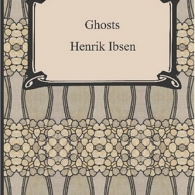Henrik Ibsen, Norwegian playwright, one of the renovators of universal theater, was born on 20 March 1828 in Skien, Norway. His father owned a spirit’s distillery that went bankrupt when he was six years old. When Ibsen was fifteen years old, he went to live in Grimstad, not far from his hometown, where his father had obtained a position of an assistant to a pharmacist. His contacts with the family were, for the rest of his life, sporadic.
In his twenties, Henrik Ibsen was already a freethinker, enthusiastic about the popular uprisings that broke out all over Europe. In 1850, he went to Kristiania (now Oslo) to matriculate at the university, but soon rejected the idea of studies and committed himself to write. He published his first play, the tragedy “Catalina,” which wasn’t performed. Right after he publishes a play “The Burial Mound,” which received a little attention. Norway was at that time a country politically ruled by Sweden and culturally by Denmark. In 1853, he accepted the position of director and playwright of a new theater in the city of Bergen, and four years later, he returned to Kristiania to direct another theater that in 1862 closed due to economic problems.
As director of the theater in Bergen, Ibsen tried to create a national drama. It was quite a difficult task because although the rich collection of medieval Icelandic sagas could be used as a base, the scene of his country was dominated by French dramaturgy (which gave priority to the ingenious intrigue about the depth of the characters), and the Danish language and tradition.
The experience he gained in Bergen had an incalculable value for him. As director of the theater, already married to Suzannah Thoresen, he exhibited an authority and confidence in his ideas that he had not previously shown. This is evident in his drama “The Pretenders” (1863), which is part of a series of historical themes and in which, reminiscent of Shakespeare and with great psychological precision, Ibsen shows the difficulty of the human being and finding a mission of life.
With “Brand” (1866) and “Peer Gynt” (1867), two dramas in verse, Ibsen makes his entry into world literature. The “Brand” represents the passionate will of man, and the central themes of “Peer Gynt” are doubt, ambiguity, and flight to the world of fantasy. The preacher Brand is the idealist who sacrifices everything for the sake of his mission. His demands have an absolute character. Peer Gynt, instead, is a romantic legend, with modern realistic features, bolder than Brand from the dramatic point of view.
This failure of his theater in Bergen marked the beginning of a new era in Ibsen's life. Tired of what he considered narrow-mindedness of his native country, he left for a twenty-seven-year exile to Italy and Germany, a period during which he wrote the bulk of his work. He published “Emperor and Galilean” in 1873, which he called his main work. In 1877 he wrote his first prose “Pillars of Society,” which deals with social conflicts and the clash of the old with the new. But the real success came with “A Doll's House” (1879), in which the authentic voice of the author appears for the first time.
The work caused scandal by its bold description of a woman who leaves his idyllic marriage because of his disagreement with the subordinate role that he has to play in it. She is a strong and independent hero in contrast to a weak husband and clinging to his patriarchal role. This work does not have a chronological development like the previous ones, but it works with a retrospective technique in which the past is being revealed as the action progresses.
“An Enemy of the People” (1882) describes the struggle of an individual determined to reveal the truth even when it threatens the survival of an entire city and despite the fact that his future and that of his family are at stake. The theme of honesty reappears in “The Wild Duck” (1884), but this time it is a ruthless truth, which destroys the life of a family. The truth, Ibsen now seems to say, is a drug that, poorly administered, has lethal effects. From the destinies of his characters, who are ordinary people, he drew conclusions of a brutal sincerity, but also of great subtlety and, at times, of poetic beauty, forcing the public to question the moral basis of the existence.
During the second half of the nineteenth century, the influence of the work of Henrik Ibsen substantially altered the European theater and converted it, from the entertainment, to which it had been reduced, into the theater that was original for the Greeks: an instrument to examine the soul. Other works of his works are “Love's Comedy” (1862), “Emperor and Galilean” (1873), “The League of Youth” (1869), “Ghosts” (1881), “Rosmersholm” (1886), “The Lady from the Sea” (1888), “Hedda Gabler” (1890), “John Gabriel Borkman” (1896) and “When We Dead Awaken” (1899).
Already at the pinnacle of his fame, he returned to Norway, and in 1900 he suffered the first series of stroke attacks that affected his physical and mental health. He died on May 22, 1906, in Kristiania (now Oslo).





